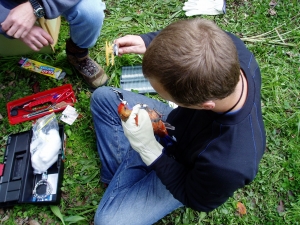Birds of a feather
Research news
Flocks of red and yellow rosellas in southern Australia are playing a leading role in helping Deakin researchers solve a longstanding riddle about the creation of new avian species.
Traditionally, it has been believed that geographical barriers were the causes of changes in species, but according to Deakin University’s Dr Mathew Berg, learned cultural characteristics, particularly birdsong, can also lead to these variations.
Reflecting the importance of this breakthrough work, Dr Berg and a team of researchers from Deakin and the CSIRO have just had a paper published in the prestigious journal PLOS ONE titled: “Learned vocal variation is associated with abrupt cryptic genetic change in a parrot species complex.”
“The traditional idea of how a new species would come about is that a population would get separated by a geographic barrier,” Dr Berg said.
“They are physically prevented from exchanging their genes and so gradually over a period of time they will evolve to become different species.
“We think it is not always that simple, because in southern Australia we have places where there is no physical separation between species, but where changes have occurred in the colouring of their plumage.”
Inland, the rosellas have yellow plumage, on the coast, it is red and in South Australia, there is a mix of the two colours.
“One of the ideas proposed for this is that traits or characteristics that are transmitted culturally … these are things that are learned like language … might play an important role in triggering the process because in the early stages, they don’t rely on genetic differences for evolving,” said Dr Berg, who works in Deakin’s Centre for Integrative Ecology.
“They can change quite rapidly, and in a lot of species, vocalisations that they learn are also known to be involved in who individuals prefer to mate with.
“So you might get these changes taking place quite quickly before any genetic changes can happen and they might cause different mate preferences or other differences between populations to take place.
“That might then snowball, preventing the exchange of genes between certain populations in the same way a physical barrier might.”
Humans provided the first hint that this sort of divergence could happen in birds.
“Linguistic barriers between humans often seem to be associated with genetic differences,” Dr Berg said.
“Languages of course, are something that can be learned.
“Birds also learn their songs and they use them for mating preferences.
“But in the past when people looked at this, the evidence was pretty mixed, varying from none at all to only the weakest of evidence.
“One of the ways they might have possibly gone wrong is that they’ve chosen a species where they know there are some vocalisation differences, then check to see if there are genetic differences emerging between the populations.
“When you don’t find those genetic differences it could just mean the process is at such an early stage the vocal differences are there, but the genetic ones aren’t.
“We took a different perspective.
“We used the rosella system in southern Australia which we already knew had a really interesting situation where there was one continuous population with underlying genetic differences.
“Until now we didn’t know how those differences occurred or how they were maintained.
“So we started from that angle and then looked to see if there were vocal differences across that area where these underlying genetic differences were occurring even though we had a continuous population, and that’s what we found.”
Dr Berg comes to Deakin after an extensive overseas research experience.
He did his PhD in The Netherlands before linking up with Professor Andy Bennett, then at the University of Bristol, but now also part of the CIE.
“As I was getting close to the end of my PhD, I met Andy and we just started discussing ideas for research subjects and came up with this one on the rosellas,” Dr Berg said.
“We applied for a number of grants and received funding in Britain, and also a fellowship for me to spend some time in America as well.
“I think the funding organisations agreed with us, it is very interesting biology indeed.”
Share this story
 Dr Mathew Berg measures a rosella.
Dr Mathew Berg measures a rosella.
